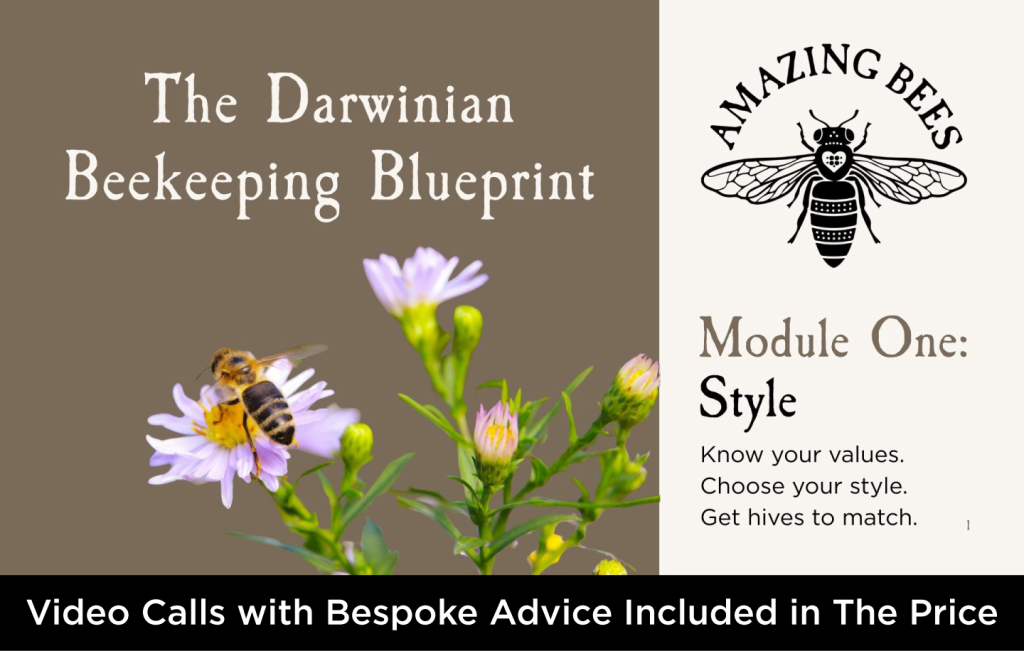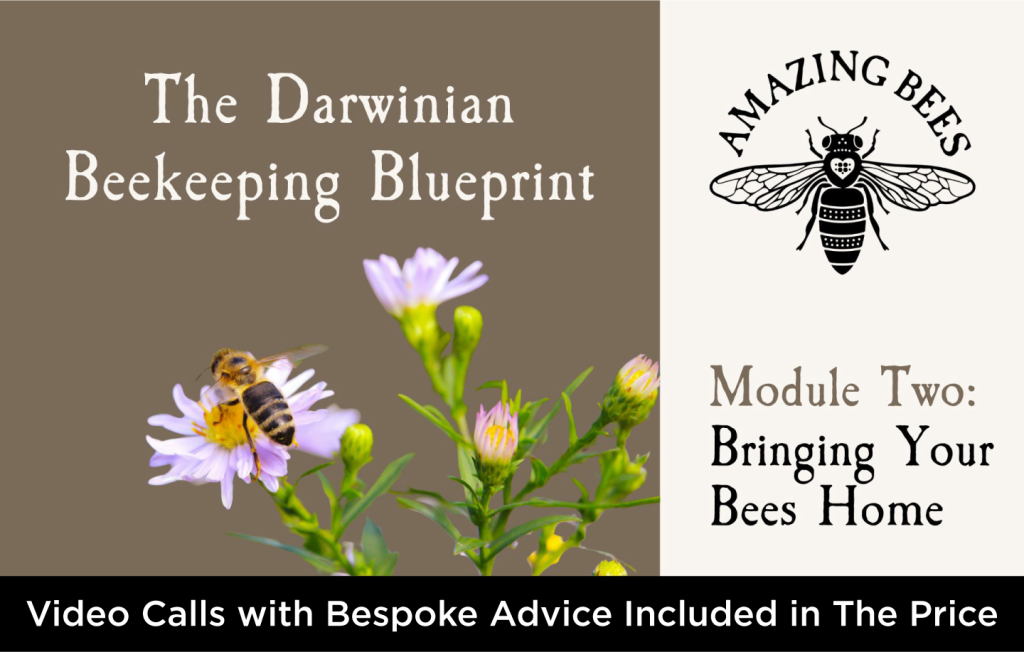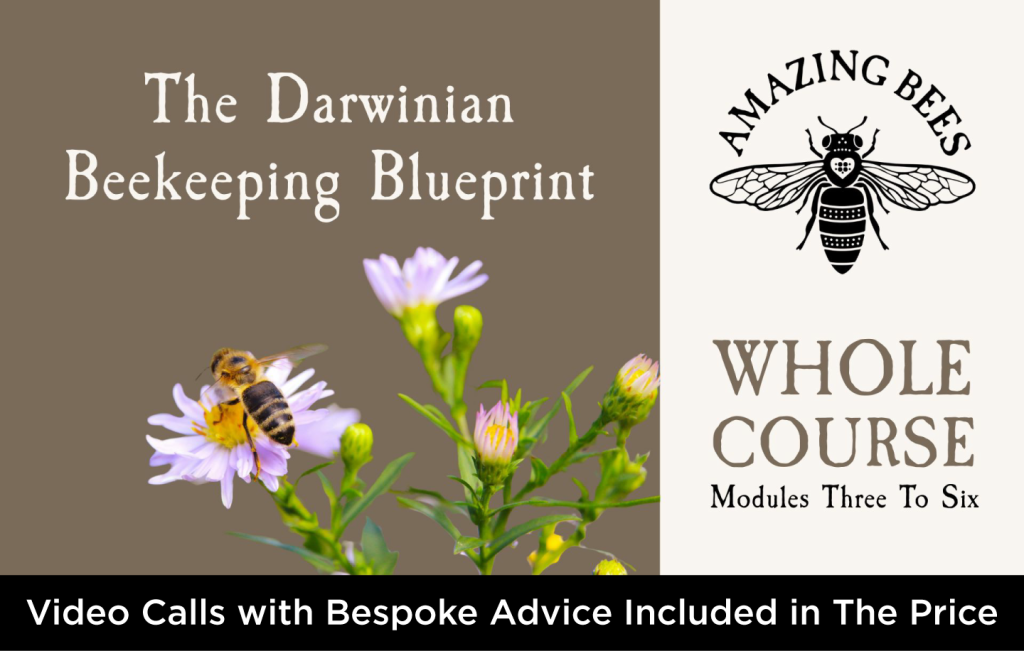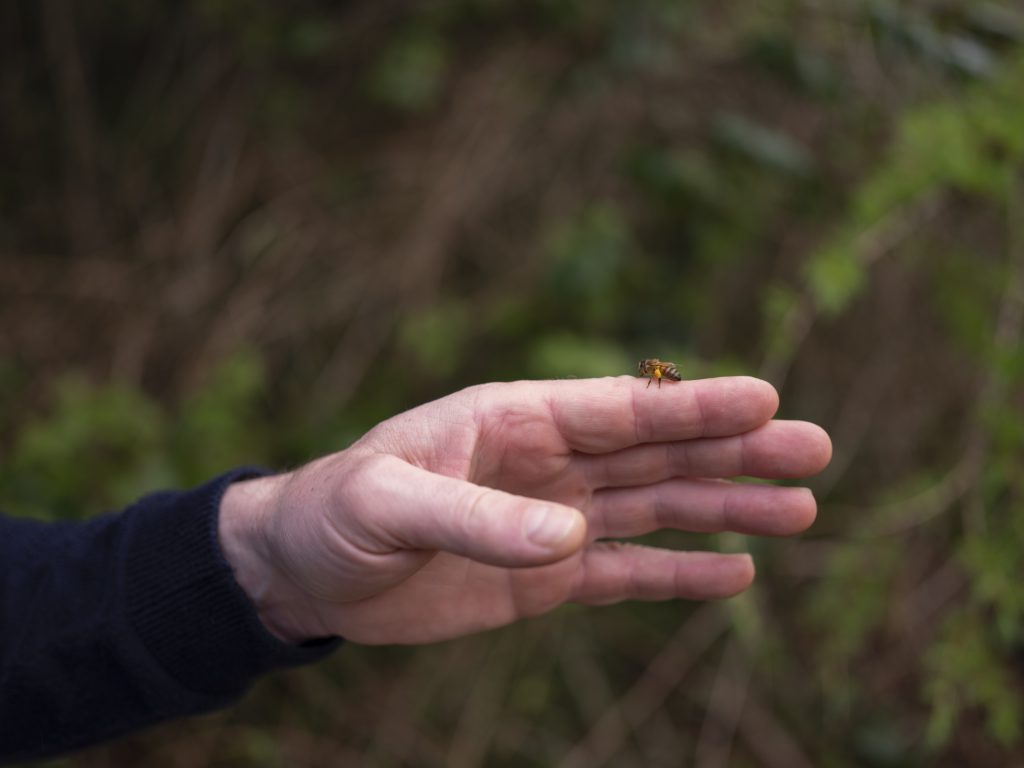The Darwinian Beekeeping Blueprint

Discover Nature's Way of Beekeeping
To me, far more important than just selling you a beekeeping course, is supporting you to enjoy your journey to becoming a successful beekeeper, because it’s only this way that I can fulfil my mission of helping more people to do treatment-free beekeeping, thus supporting the recovery of our wild honey bee population, by providing a safe space for their natural evolution to take place.
Each one of you will have slightly different circumstances and situations that can be best addressed in-person as issues arise, which is why group video calls, included in the price, are an essential part of this course’s value.

What You’ll Learn in Module One – Style (FREE):
By the end of this module you will have decided on your style of beekeeping, which informs the equipment you need.
As you grow your apiary, it is helpful to have all matching equipment, so parts are interchangeable between hives. These are an expensive long-term investment, so getting this choice right from the start could save you thousands of pounds.
The equipment you need is dictated by the style of beekeeping you wish to adopt, which in turn depends on your values and your desired beekeeping outcomes, e.g. your own fresh local honey, becoming intimately acquainted with these interesting social insects, how they work as a colony and how they fit into the wider environment, or just providing a space for bees to be, replacing the hollow trees we’ve deprived them of when we cut them down. The style of beekeeping you choose is also dictated your resources, e.g. time, money, space and physical abilities
Along the way, you’re going to learn about the history of beekeeping and the development of beekeeping technologies from honey hunting to the modern day, and some of my core values in beekeeping and how they might align with yours.
You’ll then be in a position to acquire your first beehives, ready for your bees to move into during module two.

What You’ll Learn in Module Two – Bringing Your Bees Home:
No amount of talking about bees will give you the experience of handling them. During this module you will learn where to get the opportunity to handle bees, how to prepare for your up-close encounters with them, and you will have gained your first hands-on experience with these fascinating insects. Preparing for this includes understanding bee motivations, their behaviour as a superorganism and also appropriate use of PPE and dealing with bee stings.
You will decide what bees to start with and where to get them. By the end of the module you will have your first bees and know how to care for them and prepare them for winter, ready for your first full year’s beekeeping season in Module Three.
Your bees can be obtained in a number of different ways and a few different forms. Nature’s way of producing new colonies is for the bees to swarm and find a new home. We can provide them with this home and catch our bees for free, or buy our honey bee colonies from other beekeepers. There are pros and cons to both and you will learn what these are and then implement your chosen strategy.
In this course, the bees are your teacher – you learn together with your bees, from your bees, and my role is less that of a teacher and more of a guide: helping you to understand what you’re seeing and respond in a way that serves your bees; growing a mutually beneficial relationship between your bees and you.

Get the whole course at our Special Introductory Price!
Receive everything included in Module Two, plus:
Module Three – Growing A Thriving Apiary
By now you have at least one colony of bees and know how to take care of them from August through to the beginning of April. This is where the beekeeping season really begins. In beekeeping, events often force you to deviate from your plan, and this is part of the fun and challenge. Even so it is very helpful to have such a plan in mind. By the end of the module you should know the answers to these questions, which will help you formulate a plan for the coming year: How many colonies do you want to have by the end of July? Are you hoping to harvest a honey crop this year? Do you want to produce spare colonies to sell or give away? Would you like to experiment with different hive designs? How much are you looking to intervene in the lives of your honey bees to boost productivity vs being a more passive observer?
You will learn how to grow a thriving honeybee population, and have an understanding of a range of different techniques to achieve this, from using bait hives to catch your own naturally occurring swarms, through to various methods to split colonies, including natural queen rearing and artificial queen rearing. Breeding can refer to two distinct activities: one is increasing your number of colonies through splitting, the other more correct use of the term is about selecting for specific traits and attributes in your bees and promoting these, while eliminating some of the less desirable qualities some of your bees may possess. Keeping bad bees is optional; I choose not to.
It is said that the first 20,000 bees in a colony take care of the colony’s needs, and it is the additional bees beyond this number that produce a surplus honey crop. Maintaining large colonies of honeybees while discouraging them from excessive swarming is a key feature of honey production and probably the most challenging part of beekeeping. In nature a large thriving honeybee colony is a honeybee colony ready to reproduce through swarming, and it is exactly such a large colony that produces a surplus of honey for the beekeeper to harvest. So if you have 60,000 bees in the form of 3 colonies of 20,000 bees, you have 3 colonies of bees. If on the other hand, you have a monster thriving colony of 60,000 bees, you will likely have an incredible honey crop (depending on your local conditions and management style this can be in excess of 200kg per colony per year).
Module Four: Enjoy and Relax – Notice The Gifts
You’ve done the hard part, so give yourself a pat on the back. This module is very much an appreciation of everything honey bees have to offer us. Of course this includes things like pollination services, honey, beeswax, and the very much under-appreciated propolis (some beekeepers still call it bee glue and get annoyed by the “sticky mess”). We’ll teach you how to harvest these gifts from the bees in your care, so that you can enjoy honey and bee bread straight from the comb (my favourite way to have them), or treat a mouth ulcer with propolis scraped from the hive. In module five, we’ll go even further into processing, and you’ll learn more ways to utilise hive products.
In addition to these more apparent and measurable gifts, for me, perhaps the greatest gifts I have received from my bees while learning and growing together for the last twenty years have been the far less tangible ones. Bees have lead me to greater connection with myself – teaching me to meditate, my local environment – a more detailed understanding of ecology, how all the parts fit together, and a growing obsession with syntropic permaculture. Bees have also lead me to connect with so many wonderful people resonating on similar frequencies to my own. Bees have given me a deeper understanding of how the universe works and my connection with all other conscious beings.
If you’re not already doing so, you might like to spend time just hanging out, enjoying the buzz, and maybe making some quiet observations at the hive entrance. I’ve said it before but in front of the hive is one of my favourite places to enjoy a morning cup of coffee, or sit in the evening when there is a nectar flow on, listening to the buzz of hundreds of thousands of wings busy fanning nectar drying it down to honey, and smelling the aroma of millions of flowers that is pushed out of the hive with the warm moist air the bees exhale.
Module Five: Balm Making and Harvesting Hive products
I like my honey best as it comes in the comb, better yet if it comes with pollen stored in amongst it, as this opens up a whole new world of flavours, and actually something some of my friends and customers turned me on to is an appreciation for the smoky flavours from darker (brood) comb. But many people prefer their honey without bits, so in this module we learn about honey extraction.
You can’t harvest honey without harvesting wax from comb and cappings, which I teach you how to render ready for use. I use it to make my amazing balms, and you can also use it for making beeswax candles, furniture polish, and a whole range of artisanal and industrial products and processes. You can also simply exchange it for wax foundation at your local beekeeping supplier.
This module includes all the recipes for our Amazing Bees balms, which you can copy or adapt to suit your own nose. This includes my lab-tested sun protection balms, that feel so much nicer and last for longer than any suncream you’re currently using (or avoiding because it feels so yucky!).
The ingredient that makes our skincare range so outstanding is propolis. This, to my mind, is the single most precious hive product. And in this module, we harvest and process propolis to make healing balms and medicinal tinctures. Propolis tincture is an essential for everybody’s first aid kit to deal with little scratches, post operative scarring as well as everything from a little cough to the worst tonsillitis.
Module Six: Sell and Gift
This is all about the legal stuff and other practical bits for selling your hive products. In this module we teach you what information must be on a honey label and what you can legally describe as honey, plus how to get labels and jars. We cover the legal stuff for selling your balms and cosmetics, and most importantly, things you don’t necessarily need to do, that other consultancy companies will want to sell you as a prohibitively expensive service. We are blessed to have found a biosciences company who help us with all our Cosmetic Product Safety Reports and lab testing where applicable. Speaking to other makers of similar products, I’m grateful to have found them for the excellent service and value they offer. In this module I also share my perspective on the pros and cons of selling at markets compared to working off my peddler’s cart, the flexibility this gives me, and again, the legal stuff for peddling.
Important Note: Currently we have course notes available for Modules One and Two, and you’ll automatically receive the course notes to Modules Three to Six as they are released. In our live videos and in the study group, I am happy to teach all the Modules Three to Six content before the course notes become available.
A Different Kind of Beekeeping Course
Most beekeeping courses fail in two critical ways:
- They front-load overwhelming theory without practical application
- They leave you on your own once the course ends
With the Darwinian Beekeeping Blueprint:
- You and your bees learn together through practical experience
- Christian guides you through real-world situations (bees don’t read books!)
- The course is paced to prevent overwhelm while building your confidence
- Ongoing support ensures you actually become a successful beekeeper

Why Treatment-Free Beekeeping Matters
At Amazing Bees, we believe that healthy bees come from working with natural selection, not fighting against it. When bees develop their own resistance to threats like the varroa mite, they don’t just survive—they thrive, and they pass these resilient traits to the wild bee population around them.
Every medicated colony contributes vulnerable genetics to the local bee population through drone mating. Every naturally resilient colony strengthens the entire bee community within a 10-mile radius.
Be part of the solution, not the problem.

From Christian, Amazing Bees Founder:
“I’m not here to sell you a course—I’m here to help you become a beekeeper. If twenty years ago, I knew what I know now, I would do many things differently. My mission is about the full recovery of wild honeybee populations, which means I actually need you to become a successful beekeeper and enjoy your beekeeping journey. That’s why I’m offering ongoing support through weekly video calls and our community. This is a partnership between you, your bees, and me.”
— Christian, Amazing Bees Founder
Perfect for Beginners & Transitioning Beekeepers
Whether you’re just starting your beekeeping journey or looking to transition from conventional methods to treatment-free approaches, this course is designed for you. We break down complex concepts into practical, actionable steps that anyone can follow.
Exclusive Community Support Included!
When you sign up for the free first module, you’ll receive:
- Free access to our WhatsApp community of like-minded beekeepers
- Four complimentary weekly video calls with Christian, founder of Amazing Bees
- Direct answers to your specific beekeeping questions from an expert with years of experience
- Connection with others on the same journey
Note: These valuable community features will only be available to paying members once additional modules are released, so take advantage now!.

